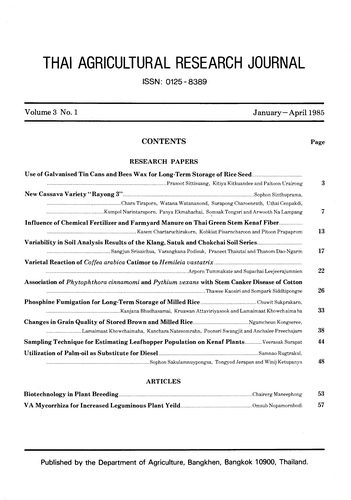Association of Phytophthora cinnamomi and pythium uexans with Stem Canker Disease of Cotton
Abstract
In 1982 a new stem canker disease of cotton (Gossypium hirsutum var. Shrisamrong 3) was recoded in the district of Chaibadarn in Lopburi province of Central thailand. Symptoms of the disease were most obvious on the stem just above the soil surface and included dried cankerous bark externally and light brown cankerous tissue internally; the margins of the diseased tissue were clearly marked by a dark brown margin. Two organisms, Phytophthora cinnamomi and Pythium vexans were consistently isolated from the active margins of the diseased tissue. Detached and intact stems and detached leaves were able to be inoculated with both P. cinnamomi and P. vexans, both fungi being pathogenic; the level of infection by P. cinnamomi was generally greater than by P. vexans.
P. cimmamomi developed best on potato-dextrose agar at 30 C; z zonate growth pattern was also observed at 35 C. The fungus was also able to infect injured bolls of the varieties Srisamrong 2 and 3 but the rate of development of the disease was slow.
This the first recorded association of P. cinnamomi and P. vexans with stem caker disease of cotton in Thailand.
Downloads
Published
How to Cite
Issue
Section
License
Thai Agricultural Research Journal



